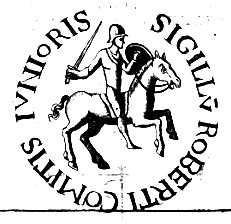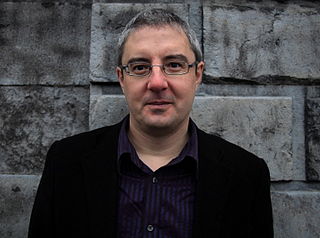Related Research Articles

Adhemarde Monteil was one of the principal figures of the First Crusade and was bishop of Puy-en-Velay from before 1087. He was the chosen representative of Pope Urban II for the expedition to the Holy Land. Remembered for his martial prowess, he led knights and men into battle and fought beside them, particularly at the Battle of Dorylaeum and Siege of Antioch. Adhemar is said to have carried the Holy Lance in the Crusaders’ desperate breakout at Antioch on 28 June 1098, in which superior Islamic forces under the atabeg Kerbogha were routed, securing the city for the Crusaders. He died in 1098 due to illness.
The 1090s was a decade of the Julian Calendar which began on January 1, 1090, and ended on December 31, 1099.

Year 1096 (MXCVI) was a leap year starting on Tuesday of the Julian calendar.

The First Crusade (1096–1099) was the first of a series of religious wars, or Crusades, initiated, supported and at times directed by the Latin Church in the medieval period. The objective was the recovery of the Holy Land from Islamic rule. While Jerusalem had been under Muslim rule for hundreds of years, by the 11th century the Seljuk takeover of the region threatened local Christian populations, pilgrimages from the West, and the Byzantine Empire itself. The earliest initiative for the First Crusade began in 1095 when Byzantine emperor Alexios I Komnenos requested military support from the Council of Piacenza in the empire's conflict with the Seljuk-led Turks. This was followed later in the year by the Council of Clermont, during which Pope Urban II supported the Byzantine request for military assistance and also urged faithful Christians to undertake an armed pilgrimage to Jerusalem.
Emicho was a count in the Rhineland in the late 11th century. He is also commonly referred to as Emicho of Leiningen or Emich of Flonheim, and not to be confused with Bishop Emicho of Leiningen. In 1096, he was the leader of the Rhineland massacres which were a series of mass murders of Jews that took place during the People's Crusade.

Robert II, Count of Flanders was Count of Flanders from 1093 to 1111. He became known as Robert of Jerusalem or Robert the Crusader after his exploits in the First Crusade.

The Rhineland massacres, also known as the German Crusade of 1096 or Gzerot Tatnó, were a series of mass murders of Jews perpetrated by mobs of German Christians of the People's Crusade in the year 1096, or 4856 according to the Hebrew calendar. These massacres are often seen as the first in a sequence of antisemitic events in Europe which culminated in the Holocaust.

Conor Kostick is an Irish historian and writer living in Dublin. He is the author of many works of history and fiction.
Gervase of Bazoches, who is also known as Gervaise, was Prince of Galilee from 1105/1106 until his death. He was born into a French noble family but migrated to the Holy Land, where King Baldwin I of Jerusalem made him senechal in the early 1100s and appointem him prince of Galilee in 1105/1106. Gervase was captured during a raid by Toghtekin, atabeg of Damascus, who had Gervase executed after Baldwin I refused to surrender three important towns in exchange for Gervase's release.
The Worms massacre was the murder of at least 800 Jews from Worms, Holy Roman Empire, at the hands of crusaders under Count Emicho in May 1096.
The role of women in the Crusades is frequently viewed as being limited to domestic or illicit activities during the Crusades. While to some extent this is true, they nevertheless played a significant role, taking part in such activities including armed combat in the battles in the Holy Land. This article focuses on the First Crusades and identifies known participants. It also highlights some of the more famous women of the later crusades. For a discussion of the sociological and religious aspects of the mixing of women with the generally male crusaders, the reader is referred to the referenced documents.
Hugh II Bardoul of Broyes, son of Barthelemy de Broyes and Elixabeth de Valois. Seigneur of Broyes, Beaufort, d'Arc-en-Barrois, and Charmentray. Hugh allegedly attacked that lands of his grandfather Raoul after his death in 1074 with the consent of King Philip, although it seems more likely that the attack was carried out by his father or guardian. Hugh joined with the Lombard contingent on the second wave of the First Crusade, dated to late 1100, serving in the army of Stephen of Blois.
Renaud II of Clermont was son of Hugh I, Count of Clermont-en-Beauvaisis and Marguerite de Roucy. Renaud became Count of Clermont-en-Beauvaisis upon his father’s death in 1101.
Robert of Bounalbergo, son of Gerard (Girard) of Buanalbergo and his wife whose name is unknown. Gerard was father to Alberada of Buonalbergo, who married Robert Guiscard and mother to Bohemond I of Antioch.
The army of Hugh the Great was formed after the Council of Clermont, led by Pope Urban II in November 1095. Hugh, son of Henry I of France, and his wife Anne of Kiev, was Count of Vermandois, de jure uxoris, due to his marriage to Adelaide of Vermandois. In August 1096, Hugh and his small army left France in prima profectione, the first army of the third wave to leave France, and travelled to Bari, Italy, and then crossed the Adriatic Sea to the Byzantine Empire, in an armada commanded by Arnout II, Count of Aarschot. When Hugh entered Constantinople, he carried a Vexillum sancti Petri, a banner given to him by the pope, Hugh being the last such noble to carry the banner.
The army of Godfrey of Bouillon, the duke of Lower Lorraine, in response to the call by Pope Urban II to both liberate Jerusalem from Muslim forces and protect the Byzantine Empire from similar attacks. Godfrey and his army, one of several Frankish forces deployed during the First Crusade, was among the first to arrive in Constantinople. The army was unique in that it included among its warriors the first three kings of Jerusalem, although Godfrey preferred the title Defender of the Holy Sepulchre, Advocatus Sancti Sepulchri, as he believed that the true King of Jerusalem was Christ. This article focuses on the members of the army rather that its exploits which are described in detail in Godfrey’s biography as well as numerous sources listed below.
The armies of Bohemond of Taranto, formed in 1097, include a major component of the First Crusade. He is regarded as the real leader of the First Crusade. He formed a second army in 1107 to defend Antioch but instead used it to attack the Byzantine emperor Alexios I Komnenos, resulting in the Treaty of Devol, codifying Bohemond’s defeat. Runciman estimates that the first army included 500 cavalry and 3500 infantrymen and other estimates that the second army was at 34,000 personnel strength are likely greatly exaggerated.
The following is an overview of the armies of First Crusade, including the armies of the European noblemen of the "Princes' Crusade", the Byzantine army, a number of Independent crusaders as well as the People’s Crusade and the subsequent Crusade of 1101 and other European campaigns prior to the Second Crusade beginning in 1147.
Corba of Thorigne, Lady of Amboise, daughter of Suplice I, beheaded for no known reason, and daughter-in-law of Fulk IV le Réchin, Count of Anjou. She inherited one of the three chateaux of Amboise.
Geoffrey Burel of Amboise was Lord of Amboise jure uxoris and a knight in the Crusade of 1101, fighting in the army of William IX. Note that this individual is not the same as the Geoffrey Burel who was a commander in the service of Peter the Hermit.
References
- ↑ A Database of Crusaders to the Holy Land. "Drogo of Nesle". Archived from the original on 2020-11-08.